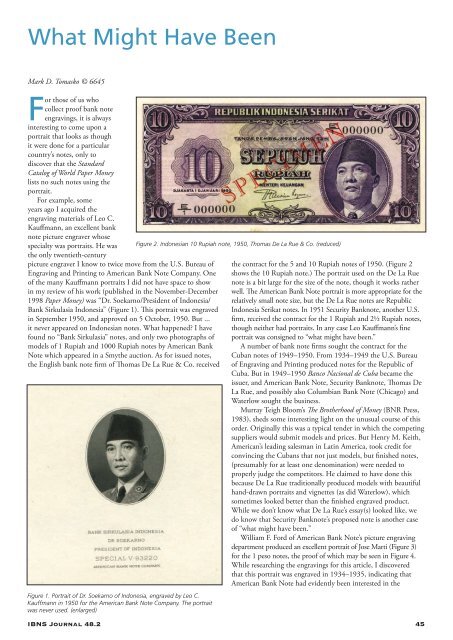Create successful ePaper yourself
Turn your PDF publications into a flip-book with our unique Google optimized e-Paper software.
What Might Have Been<br />
Mark D. Tomasko © 6645<br />
For those of us who<br />
collect proof bank note<br />
engravings, it is always<br />
interesting to come upon a<br />
portrait that looks as though<br />
it were done for a particular<br />
country’s notes, only to<br />
discover that the Standard<br />
Catalog of World Paper Money<br />
lists no such notes using the<br />
portrait.<br />
For example, some<br />
years ago I acquired the<br />
engraving materials of Leo C.<br />
Kauffmann, an excellent bank<br />
note picture engraver whose<br />
specialty was portraits. He was<br />
the only twentieth-century<br />
picture engraver I know to twice move from the U.S. Bureau of<br />
Engraving and Printing to American Bank Note Company. One<br />
of the many Kauffmann portraits I did not have space to show<br />
in my review of his work (published in the November-December<br />
1998 Paper Money) was “Dr. Soekarno/President of Indonesia/<br />
Bank Sirkulasia Indonesia” (Figure 1). This portrait was engraved<br />
in September 1950, and approved on 5 October, 1950. But ...<br />
it never appeared on Indonesian notes. What happened? I have<br />
found no “Bank Sirkulasia” notes, and only two photographs of<br />
models of 1 Rupiah and 1000 Rupiah notes by American Bank<br />
Note which appeared in a Smythe auction. As for issued notes,<br />
the English bank note firm of Thomas De La Rue & Co. received<br />
Figure 1. Portrait of Dr. Soekarno of Indonesia, engraved by Leo C.<br />
Kauffmann in 1950 for the American Bank Note Company. The portrait<br />
was never used. (enlarged)<br />
Figure 2. Indonesian 10 Rupiah note, 1950, Thomas De La Rue & Co. (reduced)<br />
the contract for the 5 and 10 Rupiah notes of 1950. (Figure 2<br />
shows the 10 Rupiah note.) The portrait used on the De La Rue<br />
note is a bit large for the size of the note, though it works rather<br />
well. The American Bank Note portrait is more appropriate for the<br />
relatively small note size, but the De La Rue notes are Republic<br />
Indonesia Serikat notes. In 1951 Security Banknote, another U.S.<br />
firm, received the contract for the 1 Rupiah and 2½ Rupiah notes,<br />
though neither had portraits. In any case Leo Kauffmann’s fine<br />
portrait was consigned to “what might have been.”<br />
A number of bank note firms sought the contract for the<br />
Cuban notes of 1949–1950. From 1934–1949 the U.S. Bureau<br />
of Engraving and Printing produced notes for the Republic of<br />
Cuba. But in 1949–1950 Banco Nacional de Cuba became the<br />
issuer, and American Bank Note, Security Banknote, Thomas De<br />
La Rue, and possibly also Columbian Bank Note (Chicago) and<br />
Waterlow sought the business.<br />
Murray Teigh Bloom’s The Brotherhood of Money (BNR Press,<br />
1983), sheds some interesting light on the unusual course of this<br />
order. Originally this was a typical tender in which the competing<br />
suppliers would submit models and prices. But Henry M. Keith,<br />
American’s leading salesman in Latin America, took credit for<br />
convincing the Cubans that not just models, but finished notes,<br />
(presumably for at least one denomination) were needed to<br />
properly judge the competitors. He claimed to have done this<br />
because De La Rue traditionally produced models with beautiful<br />
hand-drawn portraits and vignettes (as did Waterlow), which<br />
sometimes looked better than the finished engraved product.<br />
While we don’t know what De La Rue’s essay(s) looked like, we<br />
do know that Security Banknote’s proposed note is another case<br />
of “what might have been.”<br />
William F. Ford of American Bank Note’s picture engraving<br />
department produced an excellent portrait of Jose Marti (Figure 3)<br />
for the 1 peso notes, the proof of which may be seen in Figure 4.<br />
While researching the engravings for this article, I discovered<br />
that this portrait was engraved in 1934–1935, indicating that<br />
American Bank Note had evidently been interested in the<br />
<strong>IBNS</strong> Journal 48.2 45


